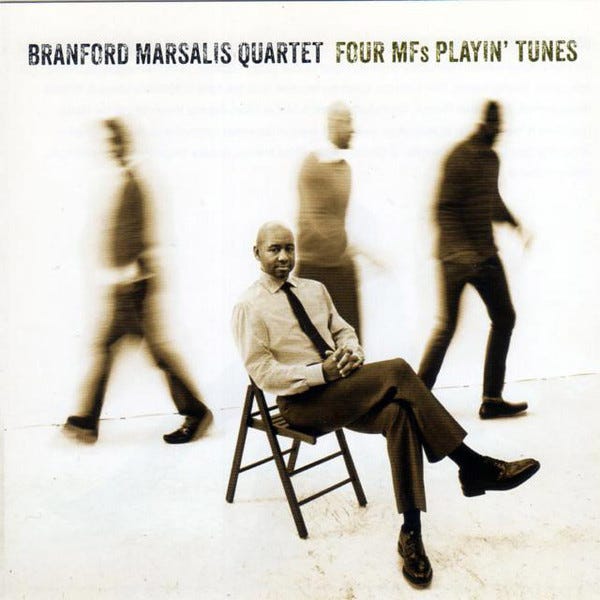Hey Jazzsters,
Today we’re jumping forward half a century.
Get ready for a wild ride…
Today’s track:
The Mighty Sword - Branford Marsalis
Artist: Branford Marsalis Quartet
Album: Four MFs Playin’ Tunes
Year: 2012
Olly’s Take
I first saw the Branford Marsalis Quartet play in Ronnie Scott’s jazz club in London as a student.
I was 19 or so. Maybe 20.
I remember sitting there in the dark club, close to the stage.
They were playing their own original compositions that night. But right at the end of the gig, they played a Lester Young tune - an old jazz classic.
It was totally different from everything they had played that night. I guess it was their way of paying resect to the greats - the people who they themselves had learned from.
I sat there, looking up at these guys… watching in awe.
The presence, the confidence, the total mastery of their art.
I was watching the best musicians of their generation showing what they could do.
10 years later, I heard today’s track - The Mighty Sword.
It reminded me of that night.
A fairly simple jazz tune, hard-hitting, executed with complete mastery, and unbelievable swing.
For me, this is modern American jazz at its most powerful.
Who am I listening to?
Branford Marsalis (soprano saxophone) is the brother of famous trumpeter Winton Marsalis.
He’s the consummate musician: In addition to his jazz quartet, he also performs classical music and composes.
He's one of the foremost jazz musicians of his generation.
What’s the music?
Here, you’re hearing Branford’s quartet:
saxophone
piano
double bass
drums
They tour the world playing their own compositions, in their trademark hard-hitting modern jazz style.
Each of the musicians in this quartet are world-renowned jazz musicians in their own right. Having them all together in a quartet is a real privilege.
3 things to listen for
The swing
I’ve used the word 'hard-hitting’ a few times already, so let’s dig into that a bit.
For me, what most defines this kind of jazz is the intensity of the swing.
It’s really high-energy, and you can best hear this by listening to the way the bass and drums play together.
Check out the start of the piano solo at 1:30, for example.
Piano improvisation over the head
One of the interesting things about this composition is the way the piano improvises while the theme tune is still playing
This begins at 1:08.
Do you like how the piano and sax work together?
(You might not… it’s quite unusual!)
Rhythmic games
Do you remember yesterday how we talked about Oscar Peterson’s use of rhythmic devices in his solo in order to create tension and release?
Here, pianist Joey Calderazzo does something very similar, in trademark New York style.
Listen from 3:05 onwards.
See how there is a lot of tension created in the music?
Keep listening until 3:39 — do you hear how all the tension is released at that point?
This is typical of this style of jazz and works to make the music interesting and always building to a climax.
(He does it again a bit later. Can you spot it?)
Share the music!
That’s all for today.
Please email me back and let me know which bits of the post you find most useful.
That way I know what to do more of!
And, lastly, if you know someone who would appreciate this, please share this newsletter with them using the button below…
Until tomorrow,
Olly Richards
P.S.
Some housekeeping…
Please “enable images” if you haven’t already. I send great images with every post
If you want to browse previous posts, you can click through to the website and scroll to your heart’s content!




